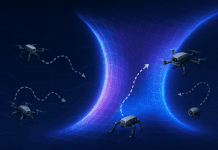This post is also available in:
 עברית (Hebrew)
עברית (Hebrew)
Long-haul routes are well suited for self-driving trucks because they are normally accomplished with driving teams of two. Haulage operators find that driving teams are difficult to recruit due to overnight driving requirements, the need to share close quarters with another person, and a significant truck driver shortage.
The US Postal Service (USPS) is exploring the feasibility of using autonomous delivery vehicle technology to reduce fuel costs, increase safe truck operation, and improve its fleet usage rate through longer hours of operation.
The Postal Service will start long-haul autonomous deliveries, transporting mail between logistics hubs in Arizona and Texas. For the pilot project, the self-driving truck company TuSimple has been contracted to perform five round trips, hauling USPS trailers more than 1,000 miles (1,600km). The project will free human drivers to focus on shorter, more dynamic and closer to home routes.
The truck will have a safety engineer and driver on board for the duration of the pilot to monitor vehicle performance and to ensure public safety. This new route is an important milestone as TuSimple scales its autonomous operations beyond Arizona and marks the company’s self-driving debut in Texas. The series of self-driving trucks will take 22 hours each, which includes overnight driving, to make the trip through Arizona, New Mexico and Texas.
With a 3,280 feet (1,000m) vision range, the company says its SAE Level 4 autonomous trucks are safer for long-haul delivery trips because they can see more and react faster than human beings, in all weather conditions, day or night, according to traffictechnologytoday.com.
“It is exciting to think that before many people will ride in a robo-taxi, their mail and packages may be carried in a self-driving truck,” said Dr. Xiaodi Hou, founder, president and chief technology officer at TuSimple. “Performing for the USPS on this pilot in this particular commercial corridor gives us specific use cases to help us validate our system, and expedite the technological development and commercialization progress.”

























